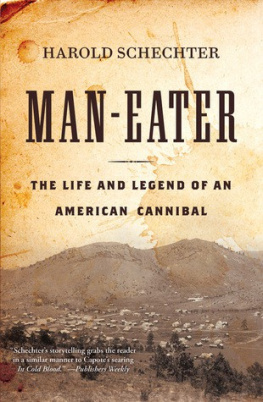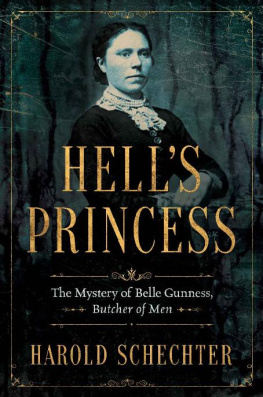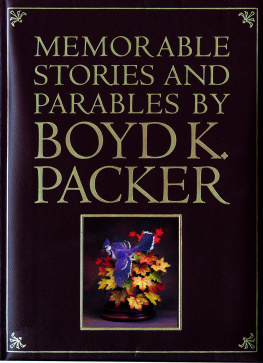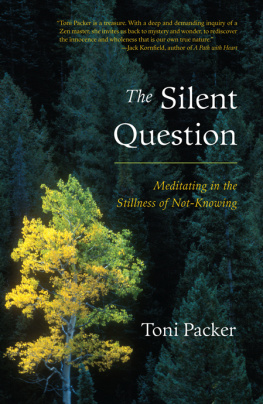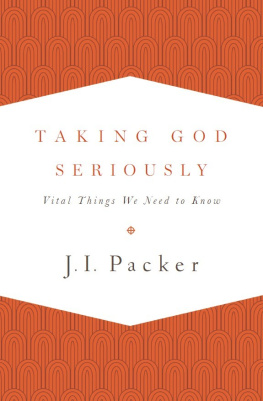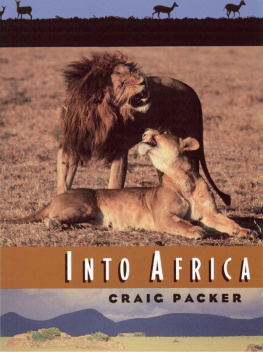Harold Schechter - Man-Eater: The Life and Legend of an American Cannibal
Here you can read online Harold Schechter - Man-Eater: The Life and Legend of an American Cannibal full text of the book (entire story) in english for free. Download pdf and epub, get meaning, cover and reviews about this ebook. City: New York, year: 2015, publisher: Little A, genre: Detective and thriller. Description of the work, (preface) as well as reviews are available. Best literature library LitArk.com created for fans of good reading and offers a wide selection of genres:
Romance novel
Science fiction
Adventure
Detective
Science
History
Home and family
Prose
Art
Politics
Computer
Non-fiction
Religion
Business
Children
Humor
Choose a favorite category and find really read worthwhile books. Enjoy immersion in the world of imagination, feel the emotions of the characters or learn something new for yourself, make an fascinating discovery.
- Book:Man-Eater: The Life and Legend of an American Cannibal
- Author:
- Publisher:Little A
- Genre:
- Year:2015
- City:New York
- Rating:5 / 5
- Favourites:Add to favourites
- Your mark:
- 100
- 1
- 2
- 3
- 4
- 5
Man-Eater: The Life and Legend of an American Cannibal: summary, description and annotation
We offer to read an annotation, description, summary or preface (depends on what the author of the book "Man-Eater: The Life and Legend of an American Cannibal" wrote himself). If you haven't found the necessary information about the book — write in the comments, we will try to find it.
Harold Schechter: author's other books
Who wrote Man-Eater: The Life and Legend of an American Cannibal? Find out the surname, the name of the author of the book and a list of all author's works by series.
Man-Eater: The Life and Legend of an American Cannibal — read online for free the complete book (whole text) full work
Below is the text of the book, divided by pages. System saving the place of the last page read, allows you to conveniently read the book "Man-Eater: The Life and Legend of an American Cannibal" online for free, without having to search again every time where you left off. Put a bookmark, and you can go to the page where you finished reading at any time.
Font size:
Interval:
Bookmark:

Psycho USA: Famous American Killers You Never Heard Of
Savage Pastimes: A Cultural History of Violent Entertainment
Fatal: The Poisonous Life of a Female Serial Killer
Fiend: The Shocking True Story of Americas Youngest Serial Killer
Bestial: The Savage Trail of a True American Monster
Depraved: The Shocking True Story of Americas First Serial Killer
Deranged: The Shocking True Story of Americas Most Fiendish Killer!
Deviant: The Shocking True Story of Ed Gein, the Original Psycho
The Whole Death Catalog: A Lively Guide to the Bitter End
The Serial Killer Files: The Who, What, Where, How, and Why of the Worlds Most Terrifying Murderers NARRATIVE NONFICTIONKiller Colt: Murder, Disgrace, and the Making of an American Legend
The Devils Gentleman: Privilege, Poison, and the Trial That Ushered in the Twentieth Century
The Mad Sculptor: The Maniac, the Model, and the Murder That Shook the Nation FICTIONThe Tell-Tale Corpse
The Mask of Red Death
The Hum Bug
Nevermore
Outcry
Dying Breath

Text copyright 2015 Harold Schechter
All rights reserved.
No part of this book may be reproduced, or stored in a retrieval system, or transmitted in any form or by any means, electronic, mechanical, photocopying, recording, or otherwise, without express written permission of the publisher.
Published by Little A, New York
www.apub.com
Amazon, the Amazon logo, and Little A are trademarks of Amazon.com, Inc., or its affiliates.
ISBN-13 (hardcover): 9781477829561
ISBN-10 (hardcover): 1477829563
ISBN-13 (paperback): 9781503944213
ISBN-10 (paperback): 1503944212
Cover design by Matthew Tanner
In memory of Kurt Brown
CONTENTS
Six miners went into the mountains To hunt for precious gold; It was the middle of the winter, The weather was dreadful cold. Six miners went into the mountains, They had nor food nor shack Six miners went into the mountains, But only one came back. The Lost Miners (nineteenth century)PROLOGUE
CANNIBAL COUNTRY In 1620, before embarking on their epochal voyage to New England, the members of the Scrooby Congregationthat intrepid band of believers we know as the Mayflower Pilgrimstook sober account of the hardships that lay before them. There wasas their chronicler, William Bradford, wrotethe ocean crossing itself, whose grueling demands were such that the weak bodies of women and other persons worn out with age and travail could never be able to endure. Those who survived the perilous journey would find themselves faced with the miseries of the land... liable to famine, and nakedness, and the want, in a manner, of all things. The change of air, diet, and drinking of water would infect their bodies with sore sickness and grievous diseases.Daunting as these physical challenges seemed, however, an even graver threat remained. Those who should escape or overcome these difficulties, wrote Bradford, should yet be in continual danger of the savage people, who are cruel, barbarous and most treacherous, being most furious in their rage, and merciless where they overcome; not being content only to kill, and take away life, but delight to torment men in the most bloody manner that may be; flaying some alive with the shells of fishes, cutting off the members and joints of others by piecemeal and broiling on the coals, eat the collops of their flesh in their sight whilst they live.Here, then, was a prospect unnerving enough to move the very bowels of men to grate within them, and make the weak to quake and tremble: enduring sickness, starvation, exposure, and other lamentable miseries, only to fall victim to cannibals.Ever since Columbus reached the New World, Europeans had thought of America as the home of cannibals. It was through Columbus, in fact, that the word cannibal entered the English language. Having made landfall in the West Indies, the legendary explorer encountered a warlike tribe who were reputed to devour their captives and whose nameCaribhe mistakenly recorded as Canib. Before long, the Spanish word canbales cannibals in its Anglicized formhad become synonymous with the man-eating savages of the New World. By Shakespeares time, the association between cannibalism and the Americas was so complete that, when the Bard conjured up his imaginary brave new world in his final play The Tempest , he populated it with two indigenous beings, the fairylike Ariel and the bloodthirsty brute Caliban, whose name is an anagram of canbal .Whether the Caribs actually engaged in anthropophagy (the technical term for man-eating) remains a matter of dispute among scholars. There is no doubt, however, that the Indian atrocities described by William Bradford were more than mere rumor. Male prisoners of the Iroquois were subjected to hideous tortures. After having their fingers chopped or bitten off, their bodies flayed, and their genitals scorched with red-hot coals, they were generally burned to death after disembowelment, some parts of their bodies having been eaten and their blood drunk in celebration by their captors.As it turned out, Bradfords darkest forebodings proved unfounded. As all American schoolchildren know, far from fill[ing] their sides full of arrowsas Bradford fearedthe native inhabitants of the New World came to the Puritans aid, teaching them how to set their corn, where to take fish, and to procure other commodities. Though half of the new arrivals perished during the first brutal winter, Bradford and the others lived to celebrate their survival with a harvest festival, inviting their Indian neighbors to join them in a three-day feast of native fare: wild turkey and water fowl, venison and shellfish, pumpkins, beans, and corn.The situation was very different for the Puritans English predecessors, the shipload of adventurers who, thirteen years before the Mayflower landed, had established the Jamestown settlement in Virginia. Despite sporadic stretches of peaceful coexistence between the newcomers and the surrounding tribes, relations grew increasingly hostile. By 1609, conditions were so dire that any white man who ventured outside the fortified confines of the settlement was likely to meet the fate of one unfortunate British captive: At a leisurely pace, his extremities were cut off with mussel shells and tossed into the fire before him; he was flayedthe skin was torn from his face and headthen disemboweled while still alive; and finally burned to ashes.Hunkered within their ill-provisioned palisade during the brutal winter of 16091610, the Jamestown colonists quickly found themselves facing starvation. George Percy, youngest son of the eighth Earl of Northumberland and one of the original band of settlers, later recounted the torments he and his companions endured. After consuming their horses and other beasts, they were driven to make shift with vermin as dogs, cats, rats, and mice. When no more rodents could be found, they began to eat boots, shoes or any other leather some could come by. At length came the ultimate horror. Maddened with hunger, some of the colonists resorted to things which seem incredible, as to dig up dead corpses out of graves and to eat them. And some have licked up the blood which hath fallen from their weak fellows. One manlater burned at the stake for the atrocitymurdered his pregnant wife, ripped the child out of her womb, then chopped the Mother in pieces and salted her for his food. When the supply ship finally arrived, Jamestowns population had been reduced from five hundred men, women, and children to sixty-four near-skeletal survivors.In the summer of 2012, four hundred years after the Jamestown colonists suffered through their catastrophic starving time, scientists made a grim discovery at the site of the settlement. Excavating a trash pit containing the bones of dogs, cats, horses, and other animals consumed during the crisis, a team of archaeologists came upon the skeletal fragments of a human being.Through state-of-the-art forensic analysis, the investigators determined that the remains were those of a female, roughly fourteen years old (based on the development of her molars) and of British ancestry... either a maidservant or the child of a gentleman. Telltale cut marks on the skull and shinbones made it incontrovertibly clear that the girl had been butchered for food.At a press conference held at the Smithsonian National Museum of Natural History in Washington, DC, Douglas Owsley, the physical anthropologist who analyzed the remains, explained that the chops to the forehead are very tentative, very incomplete. Then the body was turned over, and there were four strikes to the back of the head, one of which was the strongest and split the skull in half. A penetrating wound was then made to the left temple, probably by a single-sided knife, which was used to pry open the head and remove the brain. It seemed likely, Owsley went on, that the brain was eaten first, because it decomposes so quickly after death, followed by her tongue, cheeks, and leg muscles.The announcement that the centuries-old stories of Jamestown cannibalism had finally been corroborated by science generated headlines on both sides of the Atlantic. In reporting the news, more than one commentator noted an ironical dimension to the findings. Like William Bradford and his fellow Pilgrims, George Percy and the other members of the Jamestown settlement had left England with their heads full of stories about Native American cannibalismof New World savages who eat their enemies when they kill them, or any stranger if they take them. In the end, however, it was the English themselves who resorted to cannibalism, driven to this extremity by a harsh and unforgiving wilderness that could strip a man of all civilized restraint. Part One DEAD MANS GULCH THE PATHFINDER Asked to name the greatest explorers of the American West, most peopleat least those with a modicum of historical awarenesswould answer Meriwether Lewis and William Clark. By the mid-nineteenth century, however, Lewis and Clark had been largely forgotten by their countrymen, their achievements overshadowed by those of another trailblazer, John C. Frmont. Remembered today by few outside the ranks of professional historians, Frmont was hailed in his lifetime as The Great Pathfinder and The Hero Who Started Civilization in the West. One contemporary proclaimed that, along with Columbuss first voyage to the New World and George Washingtons military triumphs in the Revolutionary War, Frmonts deeds were the greatest events in the world... connected with the rise and progress of the United States.His renown rested on a series of surveying expeditions he undertook with the legendary scout and Indian fighter Kit Carson. In the course of these journeys, Frmont covered more ground west of the Mississippi than had any other explorer, mapped most of the Oregon Trail, and played a leading part in wresting California from Mexico. The published reports of his adventures, packed with vivid descriptions and thrilling incidents, became instant bestsellers, inspiring thousands of settlers to migrate out west.Such was Frmonts fame that, in 1856, he was nominated as the Republican Partys first presidential candidate. The ensuing campaign was one of the nastiest in the nations history. Indulging in the kind of unbridled calumny that makes modern-day mudslinging seem like the height of civility, Frmonts adversaries branded him a secret papist (a harsh accusation in an era of virulent anti-Catholic bigotry), a bastard, an adulterer, a native-born Frenchman, and the son of a prostitute. They also alleged that, during his last expedition, his men had resorted to cannibalism. Unlike some of the other imputations leveled against him, this one happened to be true.In 1848, at the behest of his father-in-law, US senator Thomas Hart Benton, Frmontwith three triumphant expeditions behind himundertook a journey to chart a route for a transcontinental railroad. The proposed path, following the thirty-eighth parallel, would cut through the Sangre de Cristo and San Juan ranges of the Rockies, Colorados roughest mountains. Though urged by trappers familiar with the region to wait until spring thaw, Frmont and his party of thirty-three men forged ahead in one of the worst winters in living memory. Either through incompetence or (as some researchers believe) deliberate treachery, their guide, a sixty-one-year-old mountain man named Old Bill Williams, eccentric even by the standards of his breed, consistently chose the worst possible routes. Trapped in the snow-choked mountains, the men froze, starved, and began dying off one by one. After exhausting their food supply, devouring the pack mules, and consuming their own boots, belts, and knife scabbards, some survived on the flesh of their dead companions. In the end, ten of the thirty-three men perished in the disaster.Frmont failed in his presidential bid, losing the 1856 election to his Democratic opponent, James Buchanan. While other factors contributed to his defeatamong them his staunch antislavery stancehistorians agree that the rumors of cannibalism associated with his fatal fourth expedition helped put an end to his political career.Twenty years later, in the same region of Colorado where the Pathfinders men suffered their harrowing ordeal, another episode of cannibalism occurred, inciting widespread horror in the American public. In contrast to the now all-but-forgotten Frmont, howeverwho had already begun his long slide into obscurityits perpetrator would achieve lasting notoriety, becoming a permanent part of our national folklore.His name was Alfred Packer, thoughas the Wests most infamous cannibalhe was known by a variety of epithets: Packer the Ghoul. The Human Hyena. The Man-Eater.THE NEW ELDORADO On January 24, 1848, James W. Marshall, a transplanted New Jersey carpenter hired to construct a sawmill on the American River near Coloma, California, spotted some glittering flakes in the water. It made my heart thump, Marshall later recalled, for I was certain it was gold. Despite efforts to keep the find a secret, word of the discovery quickly spread, unleashing a worldwide epidemic of gold fever and instigating a mass invasion of California.The earliest arrivals found nuggets for the taking. Within a decade, however, the rivers were panned out. Disillusioned miners began searching elsewhere. In 1858, a party of prospectors led by a Georgian named William Green Russell turned up a few small deposits of gold dust in the Pikes Peak country of the Southern Rocky Mountains. Newspapers trumpeted the discovery, touting the region as The New Eldorado. Heeding the rallying cry of Pikes Peak or Bust! tens of thousands of treasure hunters swarmed to the Colorado Territory in the second-greatest gold rush in US history. Mining camps sprouted throughout the mountains. In less than a year, Denver grew from a small cluster of mud-chinked log cabins and ramshackle lean-tos into a bustling settlement with a population of close to five thousand.While most of the newcomers ended up with nothing but broken hopes and busted fortunes, some became rich overnight. Millionaires were made in a matter of moments, writes one historian, as the born lucky swung their picks and felt the rock give way to... pay dirta pocket of mixed sandstone, clay, and quartz, impregnated with flour gold. From a high-grade vein, a man could realize as much as $1,500 a day, at a time when the average American laborer earned less than one-third of that amount in a year.The outbreak of the Civil War temporarily halted the stampede. With the wars end, a new army of hopefuls flocked to the region. By then, the gulches and streams of the Rockies had yielded much of their precious yellow ore. Gold, however, wasnt the only mineral treasure to be wrested from the mountains. In 1860so one story goesa prospector named Sam Conger, while camping on a meadow near Boulder Creek, fished out a nugget of silver from the water. Since Conger was hunting for gold, he attached little value to the specimen, though he kept it as a curio. Nine years later, however, after learning of the wealth issuing from Nevadas fabled Comstock silver lode, he and some partners returned to the spot, where they quickly uncovered a rich vein of the precious white metal, setting off a second frenzied rush to the Colorado Rockies.From the older mining districts north of Denver, this new wave of fortune hunters poured over the mountains until it reached the mineral-rich wilderness of the San Juans. Situated in the southwest corner of Colorado, the San Juan country is an area of spectacular beauty, its towering peaks among the highest in North America, its slopes and alpine valleys heavily forested with native conifers and deciduous trees: pine, spruce, fir, cedar, aspen, box elder, and more. With its jagged peaks, deep canyons, sheer rock walls, and dizzying gorges, it is also a notoriously harsh environment, particularly during its prolonged, brutal winters. For John C. Frmont, whose fourth expedition met its terrible fate in the area, the San Juans were the highest, most rugged, most impracticable, and inaccessible of the Rocky Mountains.The natural obstacles presented by the San Juan range, however, did nothing to stem the tide of migrants. When one early pioneer, Enos Hotchkiss, uncovered a high-grade claim east of Lake San Cristobal, thousands of silver seekers swarmed to the area in a matter of weeks.For countless men lured to the Silvery San Juans by a similar fantasy, the quest for instant riches would end in abject failure. For a few, it would lead to something far worse.DRIFTER In early October 1873, the Denver Tribune ran a piece that was reprinted in newspapers throughout the Southwest. Headlined The San Juan Silver Mines, it reported the recent find of a lode that surpasses the Comstock of Nevada in richness and hailed the San Juan District as a land of immense and apparently inexhaustible mineral resources where hundreds of rich discoveries remained to be made.Residing in the vicinity of Salt Lake City, Utah, at the time this article appeared was a thirty-one-year-old drifter named Alfred G. Packer. He was born in Allegheny County, Pennsylvania, on November 12, 1842, one of eight children of a carpenter named James Packer and his wife, Esther (ne Esther Griner). By then, of course, he had long since achieved another, far less enviable distinctionas the father of one of the nations most notorious murderers.Shortly after Alfreds birth, James moved the family to LaGrange, Indiana, where he found work as a cabinetmaker and became an active member of the Methodist Episcopal Society. About his infamous sons boyhood virtually nothing is known. At some point in Alfreds early adolescence, he was apprenticed to a shoemaker, acquiring a skill he would use throughout his life, leatherworking. He also suffered a string of violent seizures, the first symptoms of the disorder that would afflict him throughout his lifegrand mal epilepsy, a condition for which no effective treatment existed at the time.Packer was six months shy of his nineteenth birthday when the bombardment of Fort Sumter ignited the Civil War. Exactly one year later, in April 1862, he joined the Sixteenth Regiment of the US Infantry at Winona, Minnesota. His enlistment form describes him as just over five feet eight inches tall, with a fair complexion, blue eyes, and light hair (oddly, since it is clear from both photographs and eyewitness testimony that his hair was, as more than one observer described it, coal black).The regiment immediately left for North Columbus, Ohio, where Packer spent the summer months in Camp Thomas, a Union training base for new recruits. Shortly after his arrival, he proudly adorned his right arm with a military tattoo that identified him as Alferd Packer of the Second Battalion, 16th Infantry. Some historians blame the botched first name on the unknown tattooist, but the truth is that Packer, at this stage of his life, possessed such rudimentary writing skills that he couldnt correctly spell his own first name (a trait he shared with at least one of his siblings; extant letters of his older sister, Melissa, are consistently signed Malissa). Eventually, he would get it right. Documents from his later years, when he had achieved a far higher degree of literacy, are all correctly signed with his baptismal name, Alfred.Following his stint at Camp Thomas, Packer accompanied his regiment to Camp Douglas, just south of Chicagoat that time a training facility for Union soldiers, later a prisoner-of-war camp so squalid, disease-ridden, and overcrowded that its Confederate inmates called it Eighty Acres of Hell. Years afterward, in applying for a government disability pension, he would claim that he had contracted typhoid fever while performing constant, prolonged, and unnecessary guard duty at the camp and that the prolonged illness was the cause of his epilepsyone of Packers many flagrant falsehoods.Though he had enlisted for three years, Packers time in the Sixteenth Regiment came to an abrupt end shortly after Christmas 1862, when he received a disability discharge at Fort Ontario, New York. The official certificate states that he was incapable of performing the duties of a soldier because of epilepsy. In the blank space where the examining physician was to indicate the number of days that said soldier has been unfit for duty, the doctor wrote, all the time.Making his way westward, Packer enlisted again, this time in Company L of the Eighth Regiment of the Iowa Cavalry. In keeping with his penchant for self-serving fabrications, Packer would maintain that he spent time as a scout for George Armstrong Custer, a claim for which no evidence exists. Shortly after his enlistment, the regiment was sent to Tennessee, where it was attached to the defense of Nashville. A surviving company muster roll from this period offers the first documented evidence of a predatory streak in Packers behavior. In the space reserved for Remarks, the regimental scribe noted that, in November 1863, Private Packers salary had been docked $2.50roughly equivalent to fifty dollars todayfor plundering citizens of N[ash]v[ille].Packers regiment was still in Tennessee the following April when his illness brought a permanent end to his military career. This soldier has been unfit for duty for sixty days in consequence of epilepsy, the regimental surgeon wrote on Packers disability discharge paper. The paroxysms occur once every 48 hours and sometimes as often as two and three times every 48 hours.In the following years, Packer drifted ever farther west, working variously as a harness maker and saddler, trapper, teamster, hunter, and wilderness guide. As the 1860s drew to a close, he, along with hordes of other young army veterans, found himself in Colorado, prospecting for gold. After losing parts of two left fingers in an accident while mining near Breckenridge, he worked for a time as a jack whacker, leading long strings of pack mules laden with suppliesfood, lumber, tools, and dynamiteup the perilous mountain trails.Though Packers precise movements in the decade following his discharge are impossible to trace with precision, it is certain that by 1871, he was seeking his fortune in Utah. Eventually, he made his way to Bingham Canyon, where he worked at copper mining until he was sickened with lead poisoning. Back on his feet, he moved to the tiny town of Sandyhardly more than a general store and a few ramshackle buildings, about twelve miles south of Salt Lake Cityand worked in one of the many small smelters just outside of town. It wasnt long, however, before he got leaded again. The illness, Packer later testified, throwed me into fits. They thought I was going to die. Under the care of the local sawbones, one Dr. McCannwho treated him with liberal doses of castor oilPacker was back on his feet by the fall of 1873, when newspapers spread the word of the latest silver strikes in the San Juan Mountains of Colorado.Next pageFont size:
Interval:
Bookmark:
Similar books «Man-Eater: The Life and Legend of an American Cannibal»
Look at similar books to Man-Eater: The Life and Legend of an American Cannibal. We have selected literature similar in name and meaning in the hope of providing readers with more options to find new, interesting, not yet read works.
Discussion, reviews of the book Man-Eater: The Life and Legend of an American Cannibal and just readers' own opinions. Leave your comments, write what you think about the work, its meaning or the main characters. Specify what exactly you liked and what you didn't like, and why you think so.

